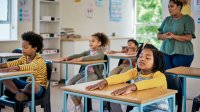Teaching Young Learners Self-Calming Skills
To help early elementary students manage big emotions, try breathing exercises and sharing how you deal with overpowering feelings.
Big, sometimes overwhelming, feelings can be hard to contain, especially for our youngest students. In the past three years, many have experienced hardships—loss, grief, isolation, food and housing insecurity—and the fallout in school continues.
Of course, working with big feelings and dysregulation in early elementary school is nothing new. Our pre-K through grade two students have always come to us brimming with excitement, while also bringing their jitters, apprehension, anxiety, and frustrations into the classroom. Unaddressed, big feelings and nervous energy can go viral, with the power to disrupt a classroom in a few minutes or less.
So what to do? How do we help our youngest students feel safe, nurtured, and connected in school? What skills and practices can we introduce for them to learn to ground themselves so that academics can thrive?
MultiSensory grounding techniques
First, we need to make sure we maintain our center and stay grounded. As the teacher, you are the thermostat (not the thermometer) in your classroom. You set the tone. So when things escalate around you, feel your feet on the ground, take a deep breath, rub that stone you carry in your pocket for times like this, or take a whiff of that bottle of calming essential oil. You might also use calming self-talk, like “I’ve got this” and “Easy does it.” According to research, silently messaging ourselves can reframe the story in our head and push back on the brain’s stress response.
Consider sharing your practices with students in the moment; as you feel your blood pressure rising, you might name your own big feelings. Model and talk students through some five-finger (aka starfish) breaths as you compose yourself. Invite students to breathe along with you as you take everyone’s feelings down a few levels. And if multisensory breathing isn’t your thing, consider modeling self-talk or progressive muscle relaxation. Whatever it is that works for you, share it. Letting young people know that we, as adults, experience big feelings, too—and that we have ways to work through them—is powerful stuff.
Have a mindful practice for students to draw on when the going gets tough. They don’t call it a “practice” for nothing. Starting the school day with some starfish, rainbow, or snake breaths can help students learn how to calm and center themselves. Some teachers I work with add mindful movement. As students develop a practice that works for them, they can return to it more easily in moments when big feelings threaten to overwhelm them.
Have you ever passed the quiet? This magical practice was shared with me by a pre-K teacher, Mr. Holifield, years ago. He would cup his hands and announce in a quiet whisper that he had the quiet. He’d look into his hands and nod excitedly. Students would perk up and lean in to see what was happening. Mr. Holifield’s contained excitement was contagious, and as he had his students pass the quiet around the circle, their rowdy and unregulated excitement calmed down. Mr. Holifield was the classroom thermostat, always.
Create a soothing environment. Playing calm, rhythmic music in your classroom is another way to intentionally quiet the senses. Fluorescent classroom lights can be activating, so consider dimming them; or, if possible, rely on natural light or introduce warmer light sources altogether. I once worked with a teacher who used calming essential oils in her classroom. I made sure to always pop in when walking by her room, inhaling deeply, before going on my way again.
Build a peace corner. Once you’ve introduced your students to centering and grounding techniques, peace corners can provide them with a place to practice. To start, ask students to draw their peaceful place and discuss what it is about their place that makes it peaceful. Next, look around the room and decide together where a peace corner could go. Also ask students about tools they use to calm themselves. Stuffies? Paper and crayons to draw or doodle? Books about feelings? A glitter jar perhaps? Decorate the space together using student artwork. Once it’s ready, have students take turns visiting, emphasizing that we all have moments in which we need to collect ourselves, including us, the adults.
Social and emotional learning (SEL) is key. As teachers, we know that teaching students skills is important. As is practice. Consider introducing talking circles to invite students to share their stories and perspectives while they practice mindful listening and patiently wait their turn. As the talking piece goes around, students make connections with other students, feel less alone, and are able to better understand where peers are coming from. The connections, empathy, and skills that students build in circles can be tapped when they get into a dispute or altercation. Guided skillfully by the adults at first, students learn how to problem-solve and repair harm. With practice, students can begin to host their own circles, using a talking piece to moderate challenging conversations.
So there it is. It may seem like a lot, and we’re already dealing with a lot these days. Just take it slow, one step at a time. Reflect and learn with your students. See what works, and keep building.
